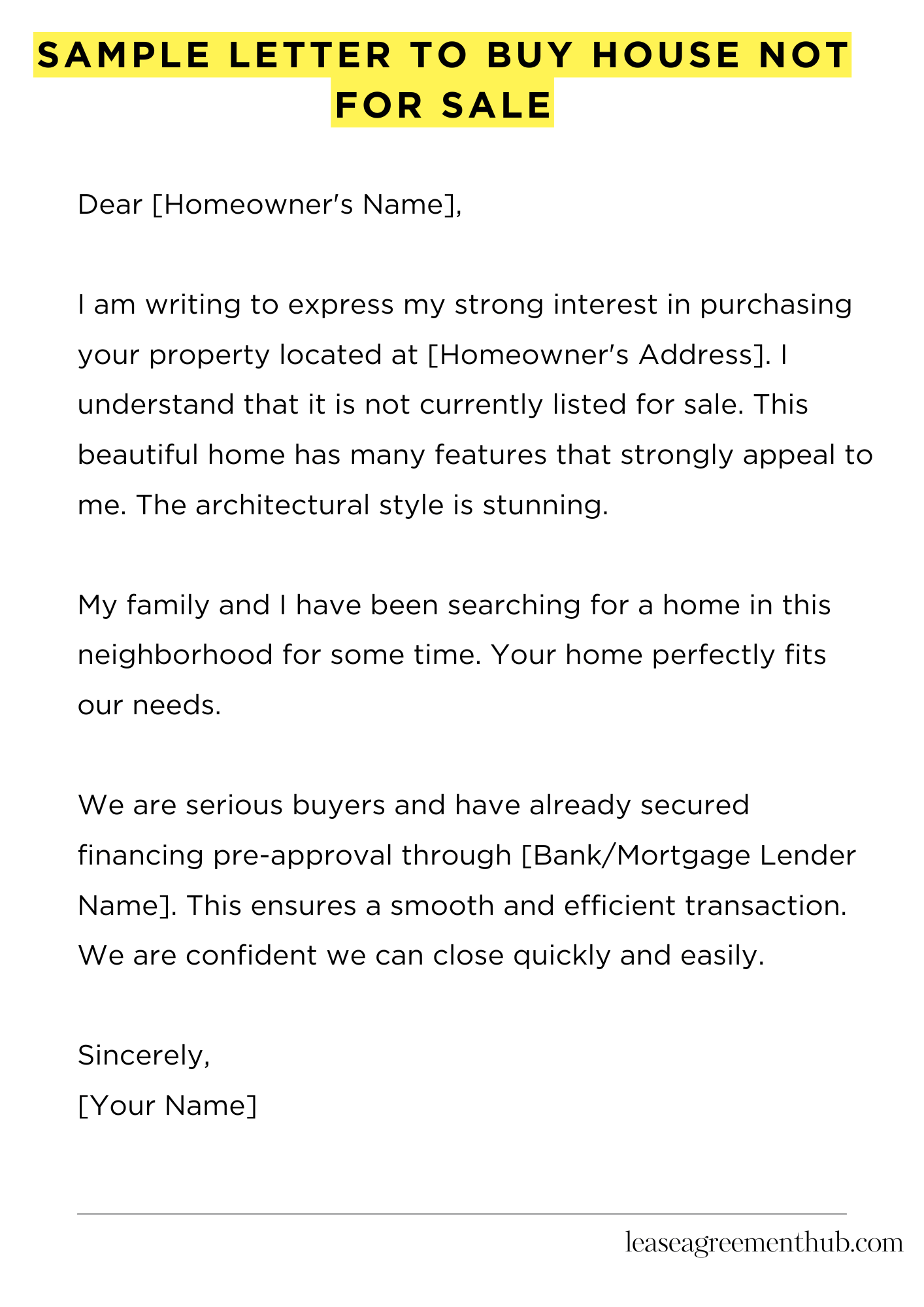Want to buy a house not officially on the market? A letter to the homeowner is your first step. It expresses your interest and makes your offer.
This article gives you example letters. These are templates. They’ll help you write your own convincing letter. Use them as a starting point.
We provide different letter samples. They cover various situations. You’ll find the perfect template to get started.
sample letter to buy house not for sale
[Your Name]
[Your Address]
[Your Phone Number]
[Your Email Address]
[Date]
[Homeowner’s Name]
[Homeowner’s Address]
Dear [Homeowner’s Name],
I am writing to express my strong interest in purchasing your property located at [Homeowner’s Address]. I understand that it is not currently listed for sale. This beautiful home has many features that strongly appeal to me. The architectural style is stunning. The large garden provides lots of space for outdoor activities. The location is ideal, close to schools and amenities.
My family and I have been searching for a home in this neighborhood for some time. Your home perfectly fits our needs. We are prepared to offer a competitive and fair price well above market value to reflect your property’s desirability and the convenience of a direct sale.
We are serious buyers and have already secured financing pre-approval through [Bank/Mortgage Lender Name]. This ensures a smooth and efficient transaction. We are confident we can close quickly and easily.
We understand that selling your home may not be something you are currently considering, but I hope you will consider our offer. We would be happy to answer any questions you may have. Could we schedule a brief meeting at your convenience to discuss this further?
Sincerely,
[Your Name]

How to Write a Letter to Buy a House Not For Sale
Understanding the Premise: A Proactive Approach
Purchasing a property not actively listed for sale requires a nuanced strategy. It demands more than a simple offer; it necessitates a compelling narrative, demonstrating your genuine interest and offering a proposition too tempting to refuse. Ignoring this crucial aspect will likely result in a swift dismissal.
Identifying Your Target: Diligent Research is Paramount
Before composing your missive, meticulous research is mandatory. Identify the homeowner; direct mail addressed to “Occupant” is rarely efficacious. Understanding the property’s history—assessments, permits, any recent improvements—can add weight to your proposal. The more you know, the more persuasive you can be. This is crucial for crafting a targeted and effective letter.
Crafting Your Salutation: The Art of the Opening
Avoid generic greetings. Personalize the salutation. If possible, learn the homeowner’s name and use it. A formal “Dear Mr./Ms. [Last Name]” is acceptable. Begin by expressing your genuine admiration for the property, highlighting specific features that resonate with you. Avoid hyperbole; sincerity is paramount.
Articulating Your Offer: A Clear and Concise Proposition
Clearly state your intention to purchase the property. Present a concrete, competitive offer—research comparable sales in the area to inform your valuation. Specify your financing options and timeline for closing. Include an earnest money deposit detail, showcasing your seriousness. Transparency is key.
Highlighting Your Strengths: Beyond the Financial
This is not merely a financial transaction; it’s a transfer of stewardship. Highlight your attributes that make you an ideal buyer: a stable financial situation, a commitment to maintaining the property, perhaps even a connection to the neighborhood’s ethos. Emphasize what makes you a desirable candidate beyond your financial capabilities.
The Closing Gambit: A Call to Action
Conclude by reiterating your interest and providing contact information. Propose a convenient time for a meeting or a phone call. Express your gratitude for their consideration, and leave them with a positive and memorable impression. This is your final opportunity to persuade.
The Postscript: A Touch of Finesse
A well-placed postscript (P.S.) can leave a lasting impression. You could reiterate a key selling point or mention something you previously omitted. Use this space judiciously to add a final touch of persuasion, leaving the homeowner with a lingering sense of your genuine enthusiasm and serious intent.
FAQs about sample letter to buy house not for sale
Purchasing a home not currently on the market requires a strategic approach. A well-crafted letter can significantly increase your chances of success.
What information should I include in my letter to the homeowner?
Your letter should clearly state your interest in purchasing their property, highlight your financial capabilities (pre-approval letter is recommended), briefly explain your reasons for wanting to buy the specific house (e.g., location, features), and propose a reasonable offer. Include your contact information and express your willingness to discuss further.
How can I find the homeowner’s contact information if the house isn’t listed?
You can try utilizing online property records, contacting the local tax assessor’s office, or even hiring a professional real estate agent with access to owner databases. Respect the homeowner’s privacy and avoid aggressive tactics.
What is a suitable tone for this type of letter?
Maintain a respectful, professional, and persuasive tone. Avoid appearing desperate or overly aggressive. Highlight your genuine interest and demonstrate that you are a serious and capable buyer. A polite and courteous approach is crucial.
How should I structure my letter for maximum impact?
A concise and well-organized letter is essential. Begin with a polite introduction, clearly stating your intentions. Follow with the details mentioned above (financial capability, reasons for interest, offer), and end with a closing statement expressing your enthusiasm and availability for further communication.
What if the homeowner declines my offer? Should I follow up?
Respect their decision if they initially decline. A brief, polite follow-up email or letter a few weeks later expressing continued interest may be acceptable, but avoid being persistent if they’ve clearly stated they aren’t interested. Be prepared for potential rejection.
Related: